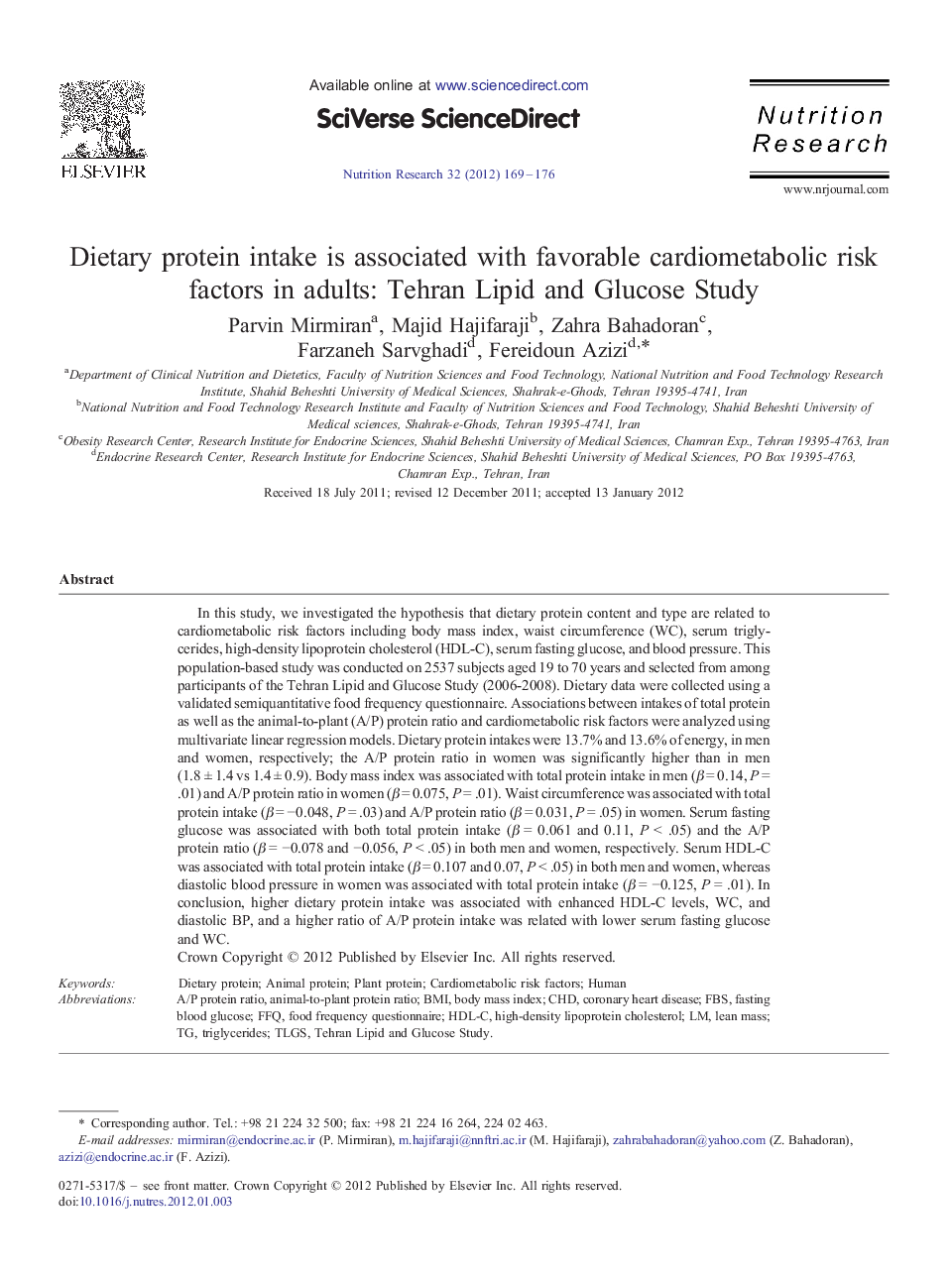| کد مقاله | کد نشریه | سال انتشار | مقاله انگلیسی | نسخه تمام متن |
|---|---|---|---|---|
| 5904599 | 1158021 | 2012 | 8 صفحه PDF | دانلود رایگان |
عنوان انگلیسی مقاله ISI
Dietary protein intake is associated with favorable cardiometabolic risk factors in adults: Tehran Lipid and Glucose Study
دانلود مقاله + سفارش ترجمه
دانلود مقاله ISI انگلیسی
رایگان برای ایرانیان
کلمات کلیدی
HDL-CTLGSCHDFFQFBSHuman - انسانcoronary heart disease - بیماری عروق کرونر قلبTriglycerides - تریگلیسریدLean mass - توده لاغرbody mass index - شاخص توده بدنBMI - شاخص توده بدنیCardiometabolic risk factors - عوامل خطر Cardiometabolicfasting blood glucose - قند خون ناشتاhigh-density lipoprotein cholesterol - لیپوپروتئین پرچگالی یا اچدیالTehran Lipid and Glucose Study - مطالعه لیپید تهران و قند خونFFQ, Food Frequency Questionnaire - پرسشنامه بسامد خوراک، پرسشنامه بسامد مصرف غذاییAnimal protein - پروتئین حیوانیDietary protein - پروتئین غذاییPlant protein - پروتئین گیاهی
موضوعات مرتبط
علوم زیستی و بیوفناوری
بیوشیمی، ژنتیک و زیست شناسی مولکولی
علوم غدد
پیش نمایش صفحه اول مقاله

چکیده انگلیسی
In this study, we investigated the hypothesis that dietary protein content and type are related to cardiometabolic risk factors including body mass index, waist circumference (WC), serum triglycerides, high-density lipoprotein cholesterol (HDL-C), serum fasting glucose, and blood pressure. This population-based study was conducted on 2537 subjects aged 19 to 70 years and selected from among participants of the Tehran Lipid and Glucose Study (2006-2008). Dietary data were collected using a validated semiquantitative food frequency questionnaire. Associations between intakes of total protein as well as the animal-to-plant (A/P) protein ratio and cardiometabolic risk factors were analyzed using multivariate linear regression models. Dietary protein intakes were 13.7% and 13.6% of energy, in men and women, respectively; the A/P protein ratio in women was significantly higher than in men (1.8±1.4 vs 1.4 ± 0.9). Body mass index was associated with total protein intake in men (β = 0.14, P = .01) and A/P protein ratio in women (β = 0.075, P = .01). Waist circumference was associated with total protein intake (β = â0.048, P = .03) and A/P protein ratio (β=0.031, P = .05) in women. Serum fasting glucose was associated with both total protein intake (β=0.061 and 0.11, P < .05) and the A/P proteinratio (β = â0.078 and â0.056, P < .05) in both men and women, respectively. Serum HDL-C was associated with total protein intake (β = 0.107 and 0.07, P < .05) in both men and women, whereas diastolic blood pressure in women was associated with total protein intake (β = â0.125, P = .01). In conclusion, higher dietary protein intake was associated with enhanced HDL-C levels, WC, and diastolic BP, and a higher ratio of A/P protein intake was related with lower serum fasting glucose andWC.
ناشر
Database: Elsevier - ScienceDirect (ساینس دایرکت)
Journal: Nutrition Research - Volume 32, Issue 3, March 2012, Pages 169-176
Journal: Nutrition Research - Volume 32, Issue 3, March 2012, Pages 169-176
نویسندگان
Parvin Mirmiran, Majid Hajifaraji, Zahra Bahadoran, Farzaneh Sarvghadi, Fereidoun Azizi,